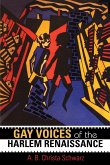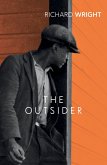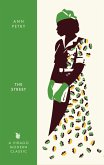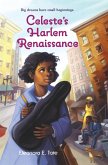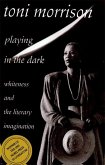A History of the Harlem Renaissance
Herausgeber: Farebrother, Rachel; Thaggert, Miriam
A History of the Harlem Renaissance
Herausgeber: Farebrother, Rachel; Thaggert, Miriam
- Broschiertes Buch
- Merkliste
- Auf die Merkliste
- Bewerten Bewerten
- Teilen
- Produkt teilen
- Produkterinnerung
- Produkterinnerung
This book presents original essays that provide comprehensive analysis of the dynamism of Harlem Renaissance literature and culture. An authoritative collection on the major writers and issues of the period, it takes stock of nearly a hundred years of Harlem Renaissance studies.
Andere Kunden interessierten sich auch für
![A History of the Harlem Renaissance A History of the Harlem Renaissance]() A History of the Harlem Renaissance49,99 €
A History of the Harlem Renaissance49,99 €![Gay Voices of the Harlem Renaissance Gay Voices of the Harlem Renaissance]() A.B. Christa SchwarzGay Voices of the Harlem Renaissance28,99 €
A.B. Christa SchwarzGay Voices of the Harlem Renaissance28,99 €![The Outsider The Outsider]() Richard WrightThe Outsider17,99 €
Richard WrightThe Outsider17,99 €![The Street The Street]() Ann PetryThe Street8,99 €
Ann PetryThe Street8,99 €![Celeste's Harlem Renaissance Celeste's Harlem Renaissance]() Eleanora E. TateCeleste's Harlem Renaissance22,99 €
Eleanora E. TateCeleste's Harlem Renaissance22,99 €![Playing in the Dark Playing in the Dark]() Toni MorrisonPlaying in the Dark40,99 €
Toni MorrisonPlaying in the Dark40,99 €![Sage in Harlem Sage in Harlem]() Charles ScruggsSage in Harlem33,99 €
Charles ScruggsSage in Harlem33,99 €-
-
-
This book presents original essays that provide comprehensive analysis of the dynamism of Harlem Renaissance literature and culture. An authoritative collection on the major writers and issues of the period, it takes stock of nearly a hundred years of Harlem Renaissance studies.
Produktdetails
- Produktdetails
- Verlag: Cambridge University Press
- Seitenzahl: 454
- Erscheinungstermin: 7. August 2025
- Englisch
- Abmessung: 229mm x 152mm x 27mm
- Gewicht: 684g
- ISBN-13: 9781108737449
- ISBN-10: 1108737447
- Artikelnr.: 74062605
- Herstellerkennzeichnung
- Libri GmbH
- Europaallee 1
- 36244 Bad Hersfeld
- gpsr@libri.de
- Verlag: Cambridge University Press
- Seitenzahl: 454
- Erscheinungstermin: 7. August 2025
- Englisch
- Abmessung: 229mm x 152mm x 27mm
- Gewicht: 684g
- ISBN-13: 9781108737449
- ISBN-10: 1108737447
- Artikelnr.: 74062605
- Herstellerkennzeichnung
- Libri GmbH
- Europaallee 1
- 36244 Bad Hersfeld
- gpsr@libri.de
Introduction: revising a renaissance Rachel Farebrother and Miriam
Thaggert; Part I. Re-reading the New Negro: 1. Cultural nationalism and
cosmopolitanism in the Harlem renaissance Daniel G. Williams; 2. Making the
slave anew: poetry, history, and the archive in New Negro renaissance
poetry Clare Corbould; 3. The New Negro among White Modernists Kathleen
Pfeiffer; 4. The Bildungsroman in the Harlem renaissance Mark Whalan; 5.
The visual image in New Negro renaissance print culture Caroline Goeser;
Part II. Experimenting with the New Negro: 6. Gwendolyn Brooks: riot after
the New Negro Renaissance Sonya Posmentier; 7. Romans à clef of the Harlem
renaissance Sinéad Moynihan; 8. Modernist biography and the question of
manhood: Eslanda Goode Robeson's Paul Robeson, Negro Fionnghuala Sweeney;
9. Modernism and women poets of the Harlem renaissance Maureen Honey; 10.
Children's Literature of the Harlem Renaissance Katharine Capshaw; Part
III. Re-mapping the New Negro: 11. London, New York, and the Black
Bolshevik renaissance: radical black internationalism during the New Negro
renaissance James Smethurst; 12. Island relations, continental visions, and
graphic networks Jak Peake; 13. 'Symbols from within': charting the
nation's regions in James Weldon Johnson's God's trombones Noelle
Morrissette; 14. Rudolph Fisher: renaissance man and Harlem's interpreter
Jonathan Munby; Part IV. Performing the New Negro: 15. Zora Neale Hurston's
early plays Mariel Rodney; 16. Zora Neale Hurston, film, and ethnography
Hannah Durkin; 17. The pulse of Harlem: African-American music and the New
Negro revival Andrew Warnes; 18. The figure of the child dancer in Harlem
renaissance literature and visual culture Rachel Farebrother; 19. Jazz and
the Harlem renaissance Wendy Martin; 20. Alain Locke and the value of the
Harlem: from racial axiology to the axiology of race Shane Vogel; Afterword
Deborah E. McDowell.
Thaggert; Part I. Re-reading the New Negro: 1. Cultural nationalism and
cosmopolitanism in the Harlem renaissance Daniel G. Williams; 2. Making the
slave anew: poetry, history, and the archive in New Negro renaissance
poetry Clare Corbould; 3. The New Negro among White Modernists Kathleen
Pfeiffer; 4. The Bildungsroman in the Harlem renaissance Mark Whalan; 5.
The visual image in New Negro renaissance print culture Caroline Goeser;
Part II. Experimenting with the New Negro: 6. Gwendolyn Brooks: riot after
the New Negro Renaissance Sonya Posmentier; 7. Romans à clef of the Harlem
renaissance Sinéad Moynihan; 8. Modernist biography and the question of
manhood: Eslanda Goode Robeson's Paul Robeson, Negro Fionnghuala Sweeney;
9. Modernism and women poets of the Harlem renaissance Maureen Honey; 10.
Children's Literature of the Harlem Renaissance Katharine Capshaw; Part
III. Re-mapping the New Negro: 11. London, New York, and the Black
Bolshevik renaissance: radical black internationalism during the New Negro
renaissance James Smethurst; 12. Island relations, continental visions, and
graphic networks Jak Peake; 13. 'Symbols from within': charting the
nation's regions in James Weldon Johnson's God's trombones Noelle
Morrissette; 14. Rudolph Fisher: renaissance man and Harlem's interpreter
Jonathan Munby; Part IV. Performing the New Negro: 15. Zora Neale Hurston's
early plays Mariel Rodney; 16. Zora Neale Hurston, film, and ethnography
Hannah Durkin; 17. The pulse of Harlem: African-American music and the New
Negro revival Andrew Warnes; 18. The figure of the child dancer in Harlem
renaissance literature and visual culture Rachel Farebrother; 19. Jazz and
the Harlem renaissance Wendy Martin; 20. Alain Locke and the value of the
Harlem: from racial axiology to the axiology of race Shane Vogel; Afterword
Deborah E. McDowell.
Introduction: revising a renaissance Rachel Farebrother and Miriam
Thaggert; Part I. Re-reading the New Negro: 1. Cultural nationalism and
cosmopolitanism in the Harlem renaissance Daniel G. Williams; 2. Making the
slave anew: poetry, history, and the archive in New Negro renaissance
poetry Clare Corbould; 3. The New Negro among White Modernists Kathleen
Pfeiffer; 4. The Bildungsroman in the Harlem renaissance Mark Whalan; 5.
The visual image in New Negro renaissance print culture Caroline Goeser;
Part II. Experimenting with the New Negro: 6. Gwendolyn Brooks: riot after
the New Negro Renaissance Sonya Posmentier; 7. Romans à clef of the Harlem
renaissance Sinéad Moynihan; 8. Modernist biography and the question of
manhood: Eslanda Goode Robeson's Paul Robeson, Negro Fionnghuala Sweeney;
9. Modernism and women poets of the Harlem renaissance Maureen Honey; 10.
Children's Literature of the Harlem Renaissance Katharine Capshaw; Part
III. Re-mapping the New Negro: 11. London, New York, and the Black
Bolshevik renaissance: radical black internationalism during the New Negro
renaissance James Smethurst; 12. Island relations, continental visions, and
graphic networks Jak Peake; 13. 'Symbols from within': charting the
nation's regions in James Weldon Johnson's God's trombones Noelle
Morrissette; 14. Rudolph Fisher: renaissance man and Harlem's interpreter
Jonathan Munby; Part IV. Performing the New Negro: 15. Zora Neale Hurston's
early plays Mariel Rodney; 16. Zora Neale Hurston, film, and ethnography
Hannah Durkin; 17. The pulse of Harlem: African-American music and the New
Negro revival Andrew Warnes; 18. The figure of the child dancer in Harlem
renaissance literature and visual culture Rachel Farebrother; 19. Jazz and
the Harlem renaissance Wendy Martin; 20. Alain Locke and the value of the
Harlem: from racial axiology to the axiology of race Shane Vogel; Afterword
Deborah E. McDowell.
Thaggert; Part I. Re-reading the New Negro: 1. Cultural nationalism and
cosmopolitanism in the Harlem renaissance Daniel G. Williams; 2. Making the
slave anew: poetry, history, and the archive in New Negro renaissance
poetry Clare Corbould; 3. The New Negro among White Modernists Kathleen
Pfeiffer; 4. The Bildungsroman in the Harlem renaissance Mark Whalan; 5.
The visual image in New Negro renaissance print culture Caroline Goeser;
Part II. Experimenting with the New Negro: 6. Gwendolyn Brooks: riot after
the New Negro Renaissance Sonya Posmentier; 7. Romans à clef of the Harlem
renaissance Sinéad Moynihan; 8. Modernist biography and the question of
manhood: Eslanda Goode Robeson's Paul Robeson, Negro Fionnghuala Sweeney;
9. Modernism and women poets of the Harlem renaissance Maureen Honey; 10.
Children's Literature of the Harlem Renaissance Katharine Capshaw; Part
III. Re-mapping the New Negro: 11. London, New York, and the Black
Bolshevik renaissance: radical black internationalism during the New Negro
renaissance James Smethurst; 12. Island relations, continental visions, and
graphic networks Jak Peake; 13. 'Symbols from within': charting the
nation's regions in James Weldon Johnson's God's trombones Noelle
Morrissette; 14. Rudolph Fisher: renaissance man and Harlem's interpreter
Jonathan Munby; Part IV. Performing the New Negro: 15. Zora Neale Hurston's
early plays Mariel Rodney; 16. Zora Neale Hurston, film, and ethnography
Hannah Durkin; 17. The pulse of Harlem: African-American music and the New
Negro revival Andrew Warnes; 18. The figure of the child dancer in Harlem
renaissance literature and visual culture Rachel Farebrother; 19. Jazz and
the Harlem renaissance Wendy Martin; 20. Alain Locke and the value of the
Harlem: from racial axiology to the axiology of race Shane Vogel; Afterword
Deborah E. McDowell.



